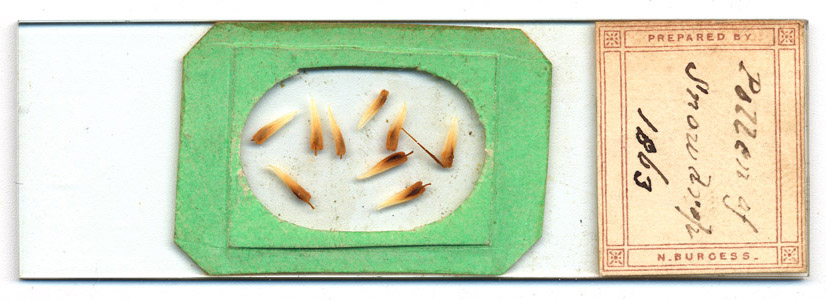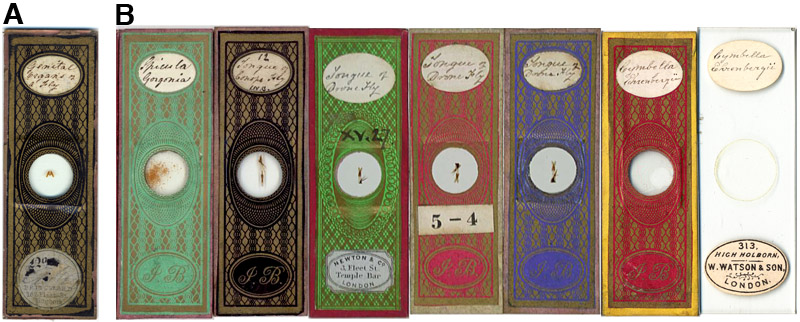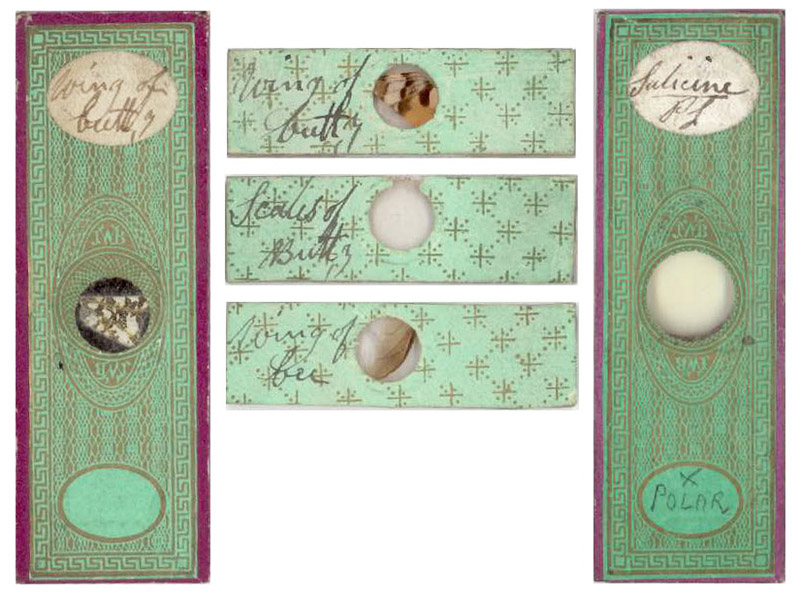
Notes on J.W. Burgess and the Victorian Microscope Slide Makers JWB and JB
Brian Stevenson, Kentucky, USA
A substantial number of professionally-made, Victorian-era microscope slides remain in existence which bear the printed monograms JB or JWB. The identities of those slide makers have long been forgotten. Brian Bracegirdle’s Microscopical Mounts and Mounters suggested that both initials may be those of J.W. Burgess. This suggestion was based upon a man by that name having been a member of the Quekett Microscopical Club during the 1860s-1870. Investigations into the life of J.W. Burgess indicate that he could not have been either JWB or JB. Moreover, Burgess’ interest in microscopy appears to have been fairly minor.
John William Burgess was born during early 1849, in Bethnal Green, Middlesex (now within London). He was the second son of Nehemiah and Mary Burgess. There are no known family connections between John Burgess and the microscope slide-maker Martin Burgess.
Nehemiah Burgess was a clerk for a wool broker. He was also an amateur naturalist, actively involved with a variety of natural history clubs. He was a member of the Executive Committee of the Quekett Microscopical Club during 1868-69. He gave a two-part lecture on “The Wools of Commerce” to the Quekett Club on the nights of 22 November and 27 December, 1867. Burgess’ subsequent paper on that topic, published in the Journal of the Quekett Microscopical Club, was widely cited into the 20th century. Nehemiah left behind a substantial library of scientific books upon his death in 1901 (Figure 1). The only microscope slide that can be confidently attributed to a member of this family is one labeled by Nehemiah (Figure 2). He donated many such slides to the Quekett Microscopical Club and Old Change Microscopical Society.

Figure 1. Advertisement for the auction of Nehemiah Burgess’ library of scientific books, following his death during the winter of 1901.

Figure 2. An 1863 microscope slide made by “N. Burgess”. Nehemiah Burgess is the only person of that name recorded as being a microscopist during 1800s England.
In contrast, John W. Burgess left almost no confirmable mark on microscopy or any other aspect of natural history. Nehemiah joined the Quekett Microscopical Club on 23 February, 1866. Son John joined the Club seven months later, on 28 September, 1866. Other than his name on membership rolls, there are no further mentions of J.W. Burgess in the Journal of the Quekett Microscopical Club. If John was indeed a professional microscope slide maker, one would expect him to have availed of opportunities to show off his wares to potential customers. There were no Club rules against this: Amos Topping frequently exhibited his work at Club functions. John Burgess quit the Club in 1876, one year after his father had resigned. It is tempting to speculate that the son may have joined the Quekett Microscopical Club primarily to please his father.
JB and JWB produced very large numbers of microscope slides, and were undoubtedly professional slide makers. Census records taken throughout his life indicate that John W. Burgess was a clerk and accountant. The 1871 census reported him to be clerk for an alpaca (wool) merchant, much like his father.
A third argument against J.W. Burgess having been JWB or JB is his birth date of 1849. The earliest known slide attributable to JB contains a secondary label from Andrew Pritchard’s shop at 162 Fleet St., London (Figure 3). Pritchard closed his Fleet St. premises at the end of 1858. Thus John W. Burgess was less than 10 years old when this slide was produced. Microscope slides attributable to JWB are even older, and include dry-mounted specimens under mica coverslips, indicative of production during the 1840s or earlier (Figure 4).

Figure
3.
Microscope slides by mounter “JB”. (A)
Slide bearing a secondary label from Andrew Pritchard, 162 Fleet St.,
dating this slide before 1859.
(B)
Additional slides by JB, with and without his monogrammed paper.

Figure 4. Microscope slides by mounter “JWB”. Two slides bearing the JWB monogram, flanking three small slides with the same handwriting. The similar handwriting is particularly obvious when comparing the two illustrated slides of butterfly wings, where the identities extend to the abbreviation “butty”. The cover slips of the small slides are made of mica, suggesting origins during the 1830s-40s.
In conclusion, there is no evidence that microscope slides monogrammed JB or JWB were produced by J.W. Burgess. To the contrary, J.W. Burgess was not a professional slide maker, was only peripherally involved with microscopy, and was born too late to have been either maker.
Who, then, were JWB and JB? The best available evidence indicates that JWB was James W. Bond (1803 - 1884), and JB was John Barnett (1816 - ca. 1885). This evidence is discussed in the current issue of The Quekett Journal of Microscopy (summer, 2010). Data supporting Bond and Barnett as having been these major slide makers are also presented at the web site http://microscopist.net
Comments to the author will be welcomed.
Acknowledgments
Many thanks to my QJM co-authors Howard Lynk, Brian Davidson and Peter Paisley for the many stimulating discussions, and to Steve Gill for advice on this and many other projects.
Resources
Bracegirdle, Brian (1998) Microscopical Mounts and Mounters, Quekett Microscopical Club, London
Bracegirdle, Brian (1998) A History of Microtechnique. Science Heritage, Lincolnwood, Illinois.
Burgess, Nehemiah (1866) Removing dried cuticle, Hardwicke’s Science-Gossip, Vol. 2, pages 257-258
Burgess, Nehemiah (1867) The Wools of Commerce Commercially and Microscopically Considered, Journal of the Quekett Microscopical Club, Vol. 1, pages 21-22 and 23-32
Census and vital statistics databases for England, accessed through ancestry.co.uk.
The Gentleman’s Magazine (1866) vol. 221, pages 619-620
Hardwicke’s Science-Gossip (1867) The Quekett Soiree, Vol. 3, page 43
Journal of the Quekett Microscopical Club (1868) Vol. 1, pages 52-53
Journal of the Quekett Microscopical Club (1869) Vol. 1, page 249
Journal of the Quekett Microscopical Club (1870) Vol. 2, pages 57-58, 121-122 and 246-248
Journal of the Quekett Microscopical Club (1872) Vol. 3, pages 20 and 27
Journal of the Quekett Microscopical Club (1876) Members List, Vol. 4
Journal of the Quekett Microscopical Club (1877) Members List, Vol. 4
Monthly Microscopical Journal (1868) Quekett Microscopical Club, Vol. 1, page 67
Monthly Microscopical Journal (1869) Old Change Microscopical Society, Vol. 2, page 335
Nature (1902) Advertisement for auction of N. Burgess’ library, Vol. 65, Feb. 6
Nuttall, Robert (2006) Marketing the achromatic microscope: Andrew Pritchard’s engiscope, Quekett Journal of Microscopy, 40:309-330.
Quarterly Journal of Microscopical Science (1867) Vol. 7, pages 167-168
Brian Stevenson, Brian Davidson, Peter Paisley, and Howard Lynk (2010), Nineteenth century microscope slide mounters JWB and JB: descriptions of their works, and evidence for them having been James W. Bond and John Barnett, Quekett Journal of Microscopy, in press.
The Third Annual Quekett Dinner, on Saturday, the 23rd November (1878) page 28.
Microscopy UK Front
Page
Micscape
Magazine
Article
Library
Published in the May 2010 edition of Micscape Magazine.
Please report any Web problems or offer general comments to the Micscape Editor .
Micscape is the on-line monthly magazine of the Microscopy UK website at Microscopy-UK .
© Onview.net Ltd, Microscopy-UK, and all contributors 1995 onwards. All rights reserved. Main site is at www.microscopy-uk.org.uk .